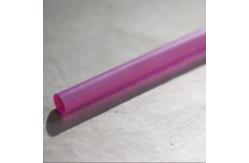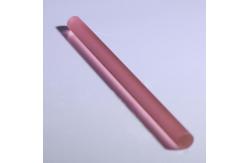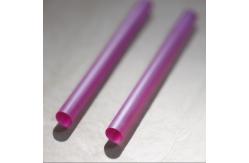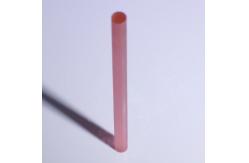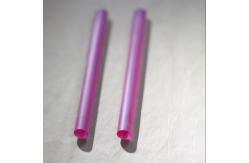Customized Ruby Laser Rods Al₂O₃:Cr³⁺ Diameter 2mm/4mm Length 10mm/20mm
|
|
Customized Ruby Laser Rods (Al₂O₃:Cr³⁺) Diameter 2mm/4mm Length 10mm/20mm
Abstract of the Ruby Laser Rod
The ruby laser rod was the first successfully realized laser gain medium in human history, first demonstrated by Theodore Maiman in 1960. Its core component is an α-alumina (Al₂O₃) single crystal doped with about 0.05% trivalent chromium ions (Cr³⁺), exhibiting a characteristic deep red color. This synthetic ruby crystal uniformly disperses chromium ions as the active medium within the corundum matrix, where a special energy level structure is formed through crystal field effects.
The ruby laser operates based on a typical three-level system principle: - Ground state energy level ⁴A₂: initial state of chromium ions
- Broad absorption bands ⁴F₁ and ⁴F₂: correspond to green (550 nm) and violet (400 nm) light absorption
- Metastable energy level ²E: includes two closely spaced levels E (694.3 nm) and 2Ā (692.9 nm)
Upon strong optical pumping, Cr³⁺ ions are excited from the ground state to the ⁴F₁/⁴F₂ bands and rapidly relax non-radiatively to the ²E metastable state. Due to the relatively long lifetime (~3 ms) of the ²E level, population inversion can be achieved, ultimately producing 694.3 nm red laser output via stimulated emission.
The Attribute Table of Ruby Laser Rods
Structural Characteristics of Ruby Laser Rod
1. Crystal Growth and Processing High-quality ruby laser rods are typically grown using the flame fusion method (Verneuil process). By precisely controlling the ratio of Al₂O₃ to Cr₂O₃ (around 0.05 wt%) and growth conditions, single crystals with excellent optical uniformity can be obtained. The crystal processing requirements include: - Rod diameter usually between 3–10 mm, length from 50–200 mm - End-face parallelism better than 10 arc seconds - Surface finish reaching λ/10 quality level - Usually cut at Brewster’s angle or coated with anti-reflection films
2.Optical and Thermal Properties
- Refractive index: 1.76 at 694.3 nm
- Thermal conductivity: approximately 40 W/(m·K)
- Thermal expansion coefficient: 5 × 10⁻⁶ K⁻¹ (parallel to c-axis)
- Mohs hardness: 9, second only to diamond
- Damage threshold: >500 MW/cm² (10 ns pulses)
3. Doping Characteristics Chromium ion concentration directly affects laser performance:
- Optimal doping concentration: 0.03%–0.07% (by weight)
- Higher concentrations cause fluorescence quenching and exacerbate thermal effects
- Chromium ions substitute for Al³⁺ sites in the crystal, occupying octahedral coordination
Operating Characteristics of Ruby Laser Rod 1. Output Characteristics
- Wavelength: primarily R₁ line (694.3 nm) at room temperature; at low temperature (77 K), R₂ line (692.9 nm) can also oscillate
- Linewidth: 0.53 nm (fluorescence), narrowing down to 0.001 nm (single longitudinal mode)
- Typical pulse energy: 0.1–10 J (Q-switched)
- Peak power: up to several hundred megawatts (mode-locked)
- Divergence angle: 0.5–5 mrad (depending on resonator design)
2. Temperature Effects Ruby lasers exhibit significant temperature dependence:
- Wavelength temperature coefficient: 0.065 Å/K
- Efficiency decreases with temperature increase (due to changes in energy level splitting)
- Thermal lensing and stress-induced birefringence need to be considered at high operating temperatures
3. Polarization Characteristics Ruby lasers naturally output linearly polarized light due to:
- Anisotropic emission characteristics of Cr³⁺ ions
- Higher gain for E∥c-axis polarization compared to E⊥c-axis - Polarization ratio can exceed 100:1
Application Fields of Ruby Laser Rod
1. Scientific Research
- Laser plasma studies: used in inertial confinement fusion experiments - Nonlinear optics: pump source for OPOs and Raman lasers - Spectroscopy: high-resolution absorption and fluorescence spectroscopy - Atmospheric sensing: laser radar (LIDAR) systems
2. Industrial Processing
- Precision drilling: gemstone bearings for watches, fuel injector nozzles - Material marking: marking special materials such as ceramics and sapphires - Welding and cutting: thin metal material processing
3. Medical Applications
- Dermatology: treatment of pigmented lesions and tattoo removal - Ophthalmology: irisectomy (gradually replaced by other lasers) - Dentistry: hard tissue treatment
4. Military and Aerospace
- Range finding and target designation: early military laser rangefinders - Laser guidance: target illumination and designation - Space communication: experimental laser links between satellites
Advantages and Limitations of Ruby Laser Rod
Main Advantages:
- High pulse energy: strong energy storage, suitable for high-energy pulse output
- Excellent optical quality: few crystal defects, high beam quality
- Mechanical stability: high hardness, strong resistance to environmental impacts
- Long lifetime: no aging issues, long service life
- Polarized output: simplifies optical system design
Main Limitations:
- Low efficiency due to three-level system: high threshold, typical efficiency only 0.1%–1%
- Significant thermal effects: unsuitable for high repetition rate operation (usually <1 Hz)
- Fixed wavelength: difficult to tune
- Requires strong optical pumping: generally pumped by flash lamps
- Higher cost: growing high-quality crystals is challenging
Technological Developments of Ruby Laser Rod
1. Cooling Technology Improvements - Conductive cooling: use of copper heat sinks with high thermal conductivity - Liquid cooling: circulation of deionized water or fluorinated liquids - Low-temperature operation: efficiency improves by 3–5 times at 77 K
2. Pumping Method Innovations - Solar pumping: early space application schemes - Laser diode pumping: improves efficiency and reduces thermal load - Side pumping: improves energy distribution uniformity
3. New Structural Designs - Slab structures: reduce thermal lensing effects - Multiple rod tandem: increase total output energy - Miniaturization: for special application scenarios
Q&A
Q:What is the primary laser wavelength of a ruby laser rod, and why does it emit red light?
A:The ruby laser emits at 694.3 nm (R₁ line) due to Cr³⁺ ion transitions in the Al₂O₃ crystal. The red color comes from the electronic transition between the ²E excited state and the ⁴A₂ ground state of Cr³⁺. At low temperatures (~77K), a secondary line at 692.9 nm (R₂ line) may also lase.
Other related products Ruby Rod Laser Technology Medical Instruments Made From Synthetic Sapphire Dia 1×7cm
|
|||||||||||||||||||||||||||||||||||||||||||||||||||||||||||||||
| Product Tags: 2mm Ruby Laser Rods Customized Ruby Laser Rods 4mm Ruby Laser Rods |
|
|
TGV Glass Substrate Through-hole Coating Semiconductor Packaging JGS1 JGS2 |
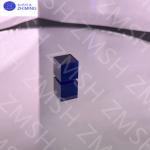
|
Royal Blue Sapphire Raw Gemstone Synthetic Colored For Durable Exquisite Jewelry & Watch Case |
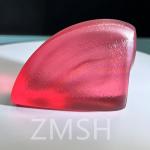
|
Paparacha sapphire raw gemstone lab-made orange pink sapphire gemstone Mohs hardness 9 |
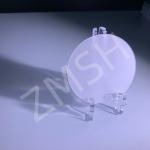
|
Sapphire Wafer Monocrystal Al2O3 DSP SSP 2inch 4inch 6inch 8inch 12inch A plane C plane |
|
|
Sapphire wafer 2inch C-plane(0001) DSP SSP 99,999% Monocrystalline Al2O3 LEDS Semiconductor |
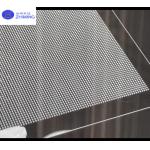
|
Through Glass Vias (TGV) For JGS1 JGS2 Sapphire Corning Glass For Sensors Manufacturing And Packaging |

